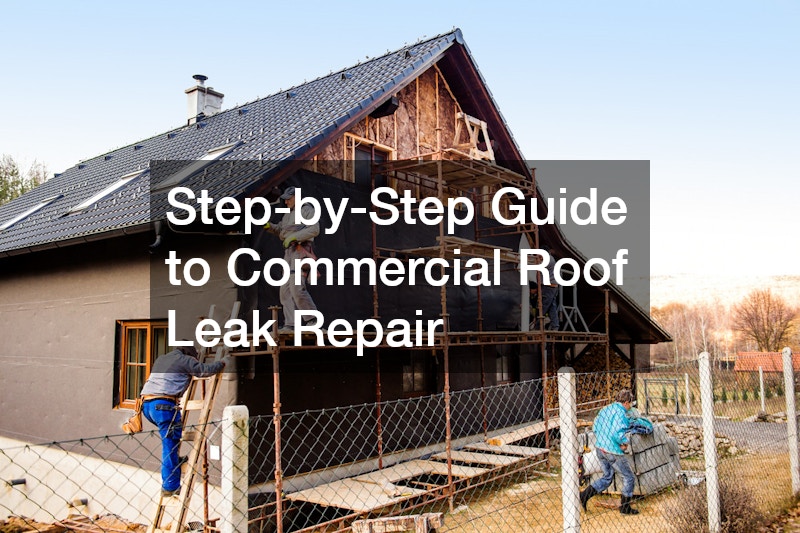Step-by-Step Guide to Commercial Roof Leak Repair
Commercial roof leaks can lead to significant structural damage, increased energy costs, and disruption of business operations if not addressed promptly. Whether caused by weather conditions, wear and tear, or poor installation, leaks should be fixed quickly to maintain the integrity of your building. This guide provides a step-by-step approach to effective commercial roof leak repair, helping you mitigate the problem before it worsens.
Identify the Source of the Leak
The first step in commercial roof leak repair is to locate the source of the problem. Leaks are not always directly above the visible water damage, as water can travel along structural elements before pooling.
Begin by inspecting areas where water stains, mold, or damage are present inside the building. Next, check the roof surface for visible signs of damage such as cracks, punctures, missing or damaged flashing, pooling water, or worn-out seals around vents or skylights.
If the source of the leak is not immediately obvious, consider conducting a water test. Gently pour water over suspected areas while another person monitors for signs of leakage inside the building. This method can help pinpoint the exact problem area.
Assess the Damage
Once the source of the leak is identified, assess the extent of the damage. Inspect both the interior and exterior of the roof to determine whether the issue is localized or widespread. Some factors to evaluate include the size of the affected area, damage to insulation or structural components, and the age and condition of the roofing material. A thorough assessment will help you decide whether to proceed with repairs or consult a professional roofing contractor for extensive damage.
Prepare the Area for Repair
Before starting the repair process, clear the area around the leak to ensure safety and accessibility. Remove any debris, standing water, or loose materials from the roof surface. If water has accumulated inside the building, dry the area to prevent mold growth and further damage.
For safety, wear appropriate protective gear, such as non-slip shoes and gloves. If working at heights, use harnesses and secure ladders or scaffolding. Proper preparation minimizes risks and creates a clean workspace for efficient repairs.
Perform Temporary Repairs if Necessary
If the weather or other circumstances prevent immediate permanent repairs, apply temporary solutions to minimize damage. Cover the affected area with a tarp or roofing tape to block water entry. Ensure the temporary fix is secured tightly to withstand wind and rain until a more permanent solution can be implemented.
Temporary repairs can buy you time to gather materials, consult professionals, or wait for favorable weather conditions to perform permanent fixes.
Repair the Leak Permanently
For a permanent fix, select materials and techniques that align with the type of roofing system you have. Common commercial roofing materials include metal, asphalt, EPDM, TPO, and PVC. The repair method will depend on the material and extent of the damage.
- For punctures or cracks, use roof sealant or patches specifically designed for the roofing material.
- Replace damaged flashing to prevent water infiltration around edges and joints.
- Reapply or replace worn-out caulking or sealants around vents, pipes, and skylights.
- For larger sections of damage, install new roofing material to match the existing surface.
Follow the manufacturer’s instructions for applying repair products to ensure a durable and watertight seal.
Inspect the Repair
After completing the repair, thoroughly inspect the area to ensure the leak is fully resolved. Check both the interior and exterior of the roof for signs of remaining moisture or weak spots. Run another water test, if necessary, to confirm that the repaired area is watertight. Address any remaining issues promptly to avoid recurring problems.
Prevent Future Leaks
Taking preventive measures can help reduce the likelihood of future leaks and extend the life of your commercial roof. Schedule regular inspections to identify potential problems early, especially after severe weather events. Keep the roof clean by removing debris, leaves, and standing water, which can contribute to deterioration. Maintain flashing, seals, and drainage systems to ensure they are functioning properly.
Investing in a professional maintenance plan can also provide peace of mind. Experienced roofing contractors can perform detailed assessments and proactive maintenance to protect your building.
When to Call a Professional
While minor leaks can often be repaired with basic tools and materials, extensive or recurring damage may require the expertise of a professional. Commercial roofs are complex systems, and improper repairs can lead to further issues. If you are unsure about the severity of the damage, or if the repair involves structural components, consult a qualified roofing contractor.
Professional contractors have the knowledge, equipment, and experience to handle complex repairs efficiently. They can also help identify underlying issues that may not be immediately visible.
Addressing commercial roof leaks promptly is essential to avoid costly repairs and prolonged downtime for your business. By following this step-by-step guide, you can efficiently identify, assess, and repair leaks while taking preventive measures to protect your investment. Whether you perform the repair yourself or hire a professional, a proactive approach ensures your commercial roof remains in excellent condition for years to come.
.


